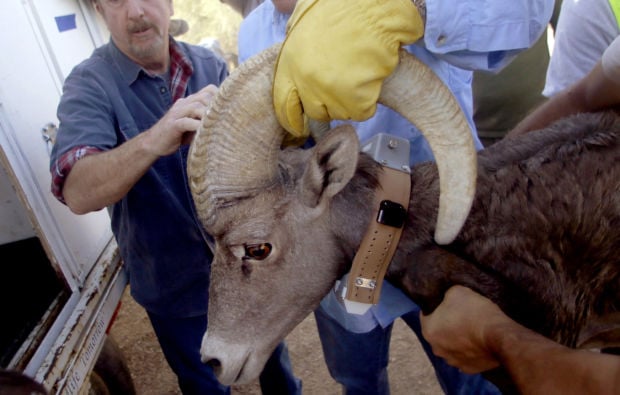A ninth bighorn sheep has died in the Catalina Mountains where 31 bighorns were released in November, state wildlife officials reported Friday.
The pregnant adult ewe was found Jan. 31 in area of steep slopes and cliffs.
Officials of the Arizona Game and Fish Department said in a news release that “evidence indicates that a cat, perhaps a young mountain lion or a bobcat was likely involved, but due to rains overnight, investigators failed to find fresh tracks or a trail, and the cat did not appear to have returned to feed on the sheep again. Thus the animal that preyed on the sheep was not removed.”
The 31 bighorns, captured in mountains near Yuma, were released in the Catalinas north of Tucson in an effort to rebuild a herd that disappeared from the range in the 1990s. In addition to the nine bighorn deaths, two mountain lions have been killed for preying on sheep.
The project has drawn widespread criticism from citizens who opposed the bighorn capture and transplant — and now express outrage at the subsequent deaths of sheep and lions. But the project has won support from a citizens advisory committee and others in the Tucson area, including sportsman Larry Audsley.
“Most people are not familiar with the history of bighorn sheep recovery in Arizona and don’t realize the extent of mortalities that occurred with previous transplants that ultimately proved successful,” Audsley said. “Restoring sheep to their historical habitat is essential to securing the future of the species.
“Opponents of the reintroduction seem to be very concerned with the welfare of individual lions and sheep,” he said. “Supporters have a broader perspective that takes in biodiversity and the well-being of the entire species. I believe that’s a major point of division between the two groups.”
Audsley added that “death is a constant among wildlife. They’re constantly dying for all sorts of reasons. That’s why they have such high birth rates, and if they weren’t dying prematurely at such a high rate we’d soon be overrun with them. That helps explain why we don’t get hysterical over the loss of a few animals as part of an effort to benefit the population as a whole.”
Some opponents of the project maintain that it amounts to “torture” of the sheep and persecution of mountain lions for doing what predators do — and they say the high number of deaths indicates that the project is on the path to failure.
“To torture the sheep in the netting and capturing is cruel,” said Rich Small, a member of a group called Friends of Wild Animals and one of many who have viewed Game and Fish Department videos of the capture. The videos showed some bighorns taking hard falls after being ensnared by nets shot from a helicopter.
“They seem to want to charge ahead with the next two relocations of bighorns” scheduled for later this year and in 2015, Small said. “I have two degrees in wildlife biology, and I don’t think it’s a good idea to put the bighorn sheep through that sort of trauma. That type of torture is not OK. The project should stop. It’s a big mistake.”
Small also expressed concern about a reference in the Game and Fish Department report that says, “As of Feb. 2, 2014, 21 of the 30 (GPS) collared sheep were known to be alive on the mountains.”
“What about the uncollared bighorn?” Small asked, referring to the single one of the 31 sheep that wasn’t fitted with a GPS tracking collar. “Is it alive or dead?”





